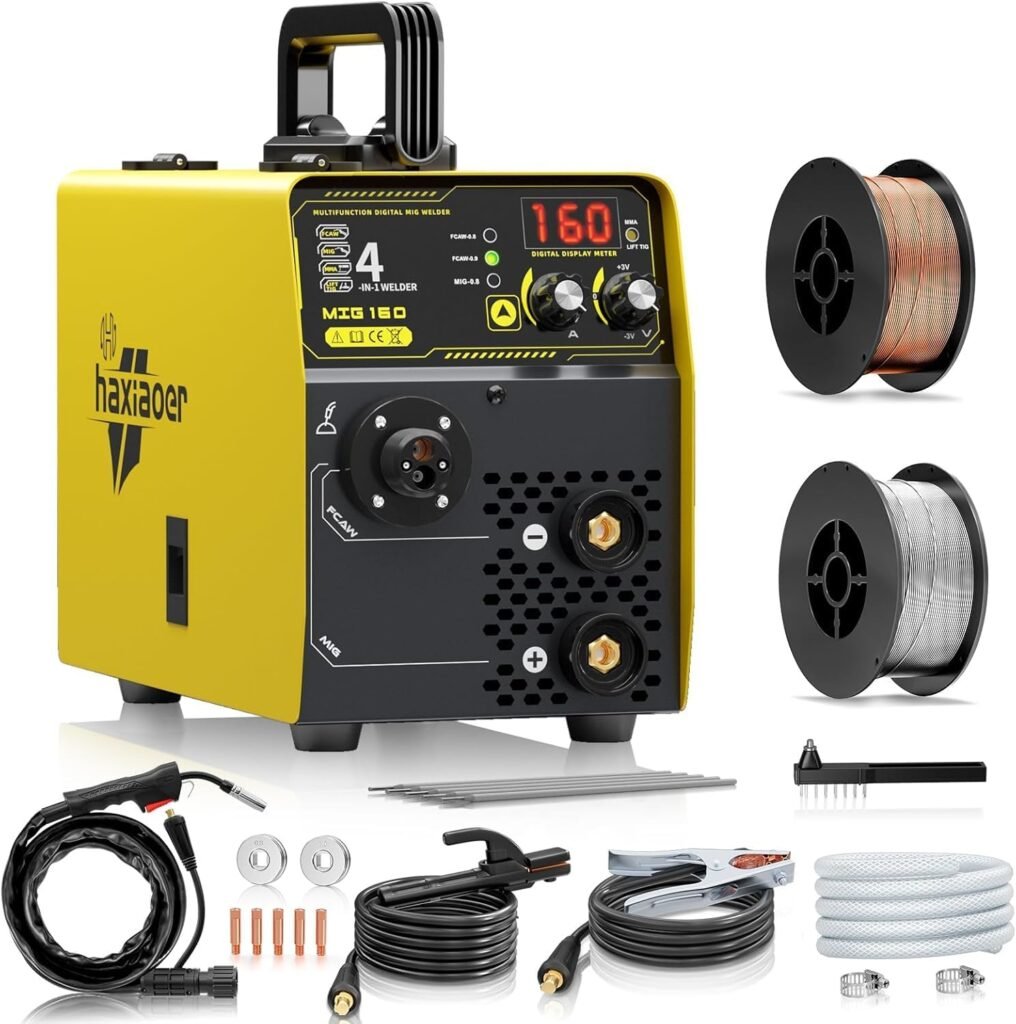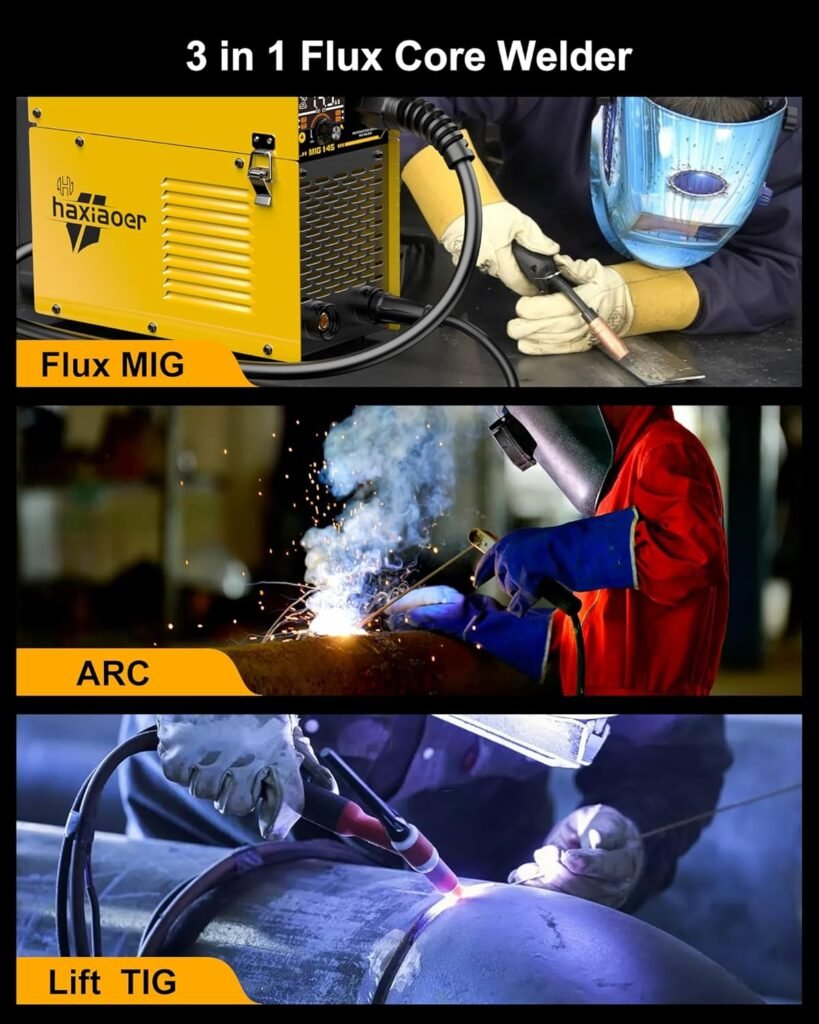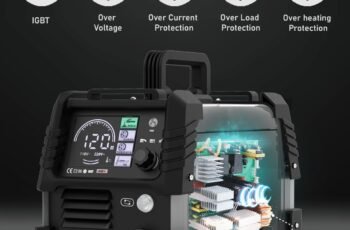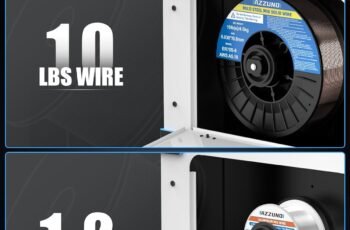Ad Blocker Detected
Our website is made possible by displaying online advertisements to our visitors. Please consider supporting us by disabling your ad blocker.
Are you looking for a compact, multifunction welder that can handle workshop repairs, farm tasks, and DIY projects without forcing you to carry multiple machines?
Product Snapshot
You’re looking at the 160A MIG Welder 4 in 1 Semi-Automatically Synergy Gas MIG/Gasless MIG/ARC/Lift TIG MIG Welding Machine with Solid Core Flux Core Wires, Yellow, which packs four welding processes into one lightweight package. It’s built to be approachable for beginners while offering features that experienced hobbyists and light pros will appreciate.
What it does
This machine supports Gas MIG (with solid ER70S-6 wire), Flux Core MIG (gasless with solid-core flux wires), MMA (stick) welding, and Lift TIG. The synergy function helps you match wire feed speed and current more easily so you can focus on your weld rather than endless adjustments.
Who it’s for
If you work on vehicles, fabricate light metal projects, maintain farm equipment, or need a single welder for a small shop, this unit is aimed at you. It’s also appropriate if you’re learning welding techniques and want a single machine to practice MIG, stick, and lift TIG.
Key Specifications
You’ll want a quick reference to the main specs before deciding. Below is a condensed breakdown so you can see power ranges, wire compatibility, and included accessories at a glance.
| Specification | Details |
|---|---|
| Model | 160A MIG Welder 4 in 1 (Yellow) |
| Welding Modes | Gas MIG (solid), Flux Core MIG (gasless), MMA (Stick), Lift TIG |
| Current Range | 20–160 A |
| Wire Diameter Compatibility | Solid: 0.8–1.0 mm (ER70S-6) / Flux Core: typically 1.0 mm included |
| Wire Feed Rollers | 0.8/0.9 K, 0.8/1.0 V rollers included |
| Torch Length | MIG torch 2 m (includes head + internal wire feed length) |
| Weight | 4.2 kg |
| Display | Large digital display |
| Protections | Overcurrent, overload, overheating, overvoltage |
| Included Consumables | 1.0 mm flux core wire, 0.8 mm solid wire, 5 contact tips, brush, gas hose |
| Interface Type | European-style torch interface |
Power & Output
You can set output from 20 A up to 160 A, which gives you a useful range for thin sheet metal up to light-to-medium gauge steel. The synergy control simplifies matching current with wire feed speed, which is especially helpful when you’re adjusting for different material thicknesses.
Welding Modes
Because it manages four processes—Gas MIG, Gasless (Flux Core) MIG, MMA stick, and Lift TIG—you won’t need separate machines for basic welding tasks. That versatility makes this a convenient single-tool solution for multiple repair and fabrication jobs.
Physical & Accessories
At 4.2 kg it’s very portable, and the package includes essential consumables and accessories so you can get welding almost immediately. You also get both solid and flux core wires preinstalled so you can try both gas and gasless MIG out of the box.
Design and Build
The case is compact and lightweight, prioritizing portability while providing a clear digital display and physical controls for quick adjustments. The yellow finish makes the unit easy to spot in a busy shop or barn.
Portability and Weight
Because it only weighs 4.2 kg, you can carry the machine to remote jobs, or move it around the garage without a second thought. Its compact footprint also saves bench space while leaving room for clamps and other tools.
Torch and Connectors
The European-style torch interface is a plus if you’re used to standard connections or plan to swap accessories. The MIG torch is 2 meters long, giving you a comfortable reach for most workshop and automotive tasks.
Synergic MIG Functionality
You’ll appreciate the synergy feature if you prefer an easier setup: select wire diameter, set your desired current, and the machine auto-recommends a wire feed speed and typical plate thickness. This reduces guesswork and helps you reach a usable arc faster.
Setting Up Synergy Mode
To operate synergy, set the wire diameter and then adjust the current; the machine calculates a compatible wire feed speed. That means you won’t have to manually hunt for the right wire speed while the arc sputters or the wire birdnests in the torch.
How It Helps Beginners
If you’re new to MIG welding, synergy simplifies learning by reducing the number of variables you must manage. You can focus on travel speed and technique rather than constantly tweaking settings.
Welding Modes Breakdown
You’ll want to know how each mode performs and what it’s best suited for. Below is a breakdown of the four modes and what to expect when you use them.
Gas MIG (Solid Wire)
Gas MIG with ER70S-6 yields cleaner welds and lower spatter when you use shielding gas, which makes it ideal for vehicle bodywork and precision projects. The arc is generally more stable than flux core, and penetration can be better when set correctly.
Flux Core (Gasless MIG)
Flux core lets you weld outdoors or in drafty conditions where shielding gas would be blown away. While you’ll see more smoke and slag to clean afterward, it’s extremely convenient for farm repairs and thicker materials where portability and speed matter more than appearance.
MMA/Stick Welding
The MMA mode offers stick welding for thicker or rusty metal where stick electrodes give you better results than MIG. This mode is useful if you need to work on outdoor repairs or thicker steel without gas or when welding positional joints.
Lift TIG
Lift TIG lets you perform TIG-style welds using a lift arc start instead of a high-frequency start, which is safer around sensitive electronics. Expect better weld appearance and precision, useful for thin sheet or stainless steels if you master the technique.
Performance and Welding Results
Real-world performance depends on setup, wire selection, gas, and your technique, but this machine gives you a usable arc and reasonable penetration across its modes. For everyday welding tasks on mild steel, it will handle typical sheet and light structural work well.
Arc Stability and Penetration
When you’re using gas MIG with correct shielding gas and a compatible wire, the arc is stable and penetration is consistent. In flux core mode, penetration can be strong, but you’ll need to manage travel speed and current to avoid excessive bead buildup.
Spatter and Clean-up
Expect lower spatter with gas MIG and more clean-up with flux core and stick. If you prefer minimal grinding, use solid wire with appropriate gas and tune your settings to minimize spatter.
Controls and User Interface
The digital display and voltage control button make it easier for you to get to a usable setting quickly. The interface is designed to be beginner-friendly, with clear feedback on current and recommended parameters.
Digital Display and Buttons
The large digital display clearly shows the current and helps you track changes as you tweak settings, so you won’t be guessing. Buttons and the voltage control knob are easy to reach and respond predictably, which helps when you’re changing settings mid-weld.
Voltage Compensation Feature
The voltage control button compensates for input voltage fluctuations to stabilize the arc. That feature matters if you’re using power from generators or in workshops with variable voltage, because it helps maintain consistent weld quality.
Safety Features
You get built-in protections that help protect the machine and keep you welding longer without unexpected shutoffs. Those protections reduce the risk of permanent damage from overload conditions and help you focus on finishing the job.
Protections
The unit includes overcurrent, overload, overheating, and overvoltage protection, which gives you an added layer of safety during heavy use. These protections will power down the unit or limit output when thresholds are reached, keeping internal components safe.
Thermal Management
The machine uses internal thermal protection and ventilation to prevent overheating during extended welds. Still, you should manage duty cycle expectations and give the unit rest periods during heavy work to extend its life.
Included Accessories and Consumables
You’ll receive a fairly complete kit that helps you start welding right away, with both solid and flux core wire options and essential spare parts. The included contact tips and feed rollers allow you to run either 0.8 or 1.0 mm wires with minimal changes.
What You Get in the Box
The package contains: 1×MIG160 welder machine, 1×MIG torch (2 m), 1×earth clamp, 1×electrode holder, 1×1.0 mm flux cored wire, 1×0.8 mm solid wire, 5×contact tips, 1×0.8/0.9 K wire feed rollers, 1×0.8/1.0 V wire feed rollers, 1×gas hose, 1×brush, and 1×user manual. Those items let you attempt most basic MIG and stick welding immediately and test both gas and gasless MIG workflows.
Useful Extras You Might Need
You’ll likely want a bottle and regulator for shielding gas if you plan to run gas MIG frequently, plus extra contact tips and wires to match the projects you plan. A proper welding cart, extra ground clamps, and a spool gun (if needed for aluminum) are good additions depending on the work you do.
Setup and First Weld
Getting the machine ready is straightforward if you follow the manual: install wire, set rollers, confirm polarity, and check gas flow if using solid wire. The synergy setup cuts down setup time by offering recommended feed speeds once you set wire diameter and current.
Gas Setup for MIG
If you use gas MIG with ER70S-6, attach a standard gas hose and regulator, set flow to the recommended range (often 15–20 L/min depending on nozzle and environment), and confirm there are no leaks. Proper gas setup improves arc stability and reduces spatter.
Wire Installation and Tensioning
Load your spool, ensure the wire path is smooth, set the appropriate drive roller (K or V groove based on wire), and tune wire tension to prevent birdnesting or slipping. Feed the wire through the torch liner and contact tip, then test feed speed with the machine off to confirm smooth delivery.
Wires and Consumables
Understanding the differences between included wires helps you choose the right consumable for the job, and storing extra spools keeps downtime low. Matching contact tip size and roller groove to wire diameter is essential for consistent feeding.
Choosing Solid vs Flux Core
Use solid ER70S-6 with shielding gas when you want cleaner welds and minimal slag; use flux core when you need portability or will be welding outdoors. Flux core typically produces more spatter and slag but gives strong deposition rates in less-than-ideal conditions.
Contact Tips and Rollers
The included 5 contact tips and two sets of rollers let you support the two primary wire diameters without much hassle. Keep spare tips on hand since tips wear with use and can affect arc stability and bead appearance when damaged.
Practical Tips and Best Practices
To get consistent welds, prepare joints properly, choose the right wire/gas combination, and maintain steady travel speed and arc length. Good technique combined with the machine’s synergy settings will yield the best results faster.
Tips for Cleaner MIG Welds
Keep surfaces clean, use a back-step or weave technique for thin sheets to avoid burn-through, and set the correct travel speed to avoid porosity. If you see excessive spatter, check gas flow, polarity, and wire feed consistency.
Tips for Lift TIG and Stick
For Lift TIG, ensure you’re comfortable with a steady hand and practice torch positioning and foot (or fixed) current adjustments if you have them. For stick welding, choose the electrode matching your parent metal and clean the joint area of heavy rust and paint for better penetration.
Maintenance and Longevity
Routine cleaning, checking wire path, replacing worn consumables, and ensuring proper ventilation will extend the life of the machine. Pay attention to the cooling fan and vents, and don’t block airflow during extended use.
Routine Care
Blow out dust periodically, inspect the torch liner and contact tips for wear, and store wires in dry conditions to prevent rust and porosity. Tighten electrical connections and replace worn rollers and tips before they compromise feed quality.
Troubleshooting Common Issues
If your wire birdnests, re-check tension, feed path, and liner condition. If you see inconsistent arc or burnback, verify polarity, contact tip size, and insulate the wire spool from rough movement; consult the manual for error indicators shown on the digital display.
Pros and Cons
You’ll find clear strengths and some trade-offs when deciding if this machine fits your needs. Weigh portability, functionality, and included accessories against duty cycle and need for external gas.
Strengths
The compact weight and four-in-one versatility make it an excellent all-around machine for hobbyists and light professionals. Synergic controls and included consumables help you get welding quickly without sourcing many extras.
Limitations
If you need heavy industrial duty cycles or deep-penetration welding at higher amps, a larger industrial welder may be more appropriate. Also, while Lift TIG is handy, full TIG performance (AC for aluminum, HF start) is not provided so dedicated TIG work on certain metals may require another machine.
Comparison with Similar Welders
Compared to single-process hobby welders, this unit gives you more flexibility and saves bench space. When compared to higher-end multi-process welders, it offers core functionality at a lower price point but may lack advanced features and longer duty cycles.
Who Should Consider Other Options
If you perform daily heavy production welding or require AC TIG for aluminum, you should consider an industrial machine or dedicated TIG welder. If duty cycle and continuous high-amperage output matter for your projects, a higher-spec unit will offer better performance.
When This Is the Right Choice
If you need a lightweight, portable multiprocess machine for automotive repair, light fabrication, or farm maintenance, this is a very compelling option. You’ll especially appreciate it if you need both gas and gasless MIG capability plus stick and Lift TIG in one box.
Final Verdict
You get a flexible, portable welding solution that is particularly well-suited for hobbyists, tinkerers, and small workshops. The synergy feature and included consumables make it a practical, user-friendly choice to get you from setup to first weld quickly.
Quick Recommendation
If you want one compact machine that covers most basic welding needs and you value portability, this 160A 4-in-1 welder is worth strong consideration. It balances versatility and accessibility, making it a practical addition to your toolbox.
Final Thoughts
You’ll get a good combination of processes and the convenience of both gas and gasless MIG, plus stick and Lift TIG capability for special use cases. Manage your expectations about duty cycle and advanced TIG features, and you’ll find this unit a reliable partner for many projects.
Frequently Asked Questions (FAQ)
Q: Can you weld aluminum with this machine? A: Not effectively with the included setup—this machine does not have a spool gun or AC TIG capability required for typical aluminum TIG welding. For MIG aluminum you’d need a spool gun, and for TIG aluminum you’d need AC output.
Q: What shielding gas should you use for solid ER70S-6? A: A common choice is 75% Argon / 25% CO2 (C25) or pure CO2 for different bead characteristics. C25 gives smoother arcs and less spatter, while CO2 increases penetration and is sometimes used for thicker sections.
Q: Is the Lift TIG function as good as a dedicated TIG machine? A: Lift TIG provides TIG-style welding and is useful for precise welds, but it won’t replace a high-end TIG machine with high-frequency start, foot pedal control, or AC output for aluminum. It’s best for occasional TIG tasks and practice.
Q: How do you handle ventilation and fumes with flux core welding? A: Use adequate ventilation, local exhaust, or weld outdoors where safe to reduce exposure to fumes. Wear appropriate respiratory protection if ventilation is limited and always follow safety recommendations for the filler wire and base metal.
If you have specific projects in mind, the materials you’ll weld, or the environments you’ll work in, tell me and I’ll give targeted setup and consumable recommendations so you get optimal results with your 160A 4-in-1 welder.
Disclosure: As an Amazon Associate, I earn from qualifying purchases.







